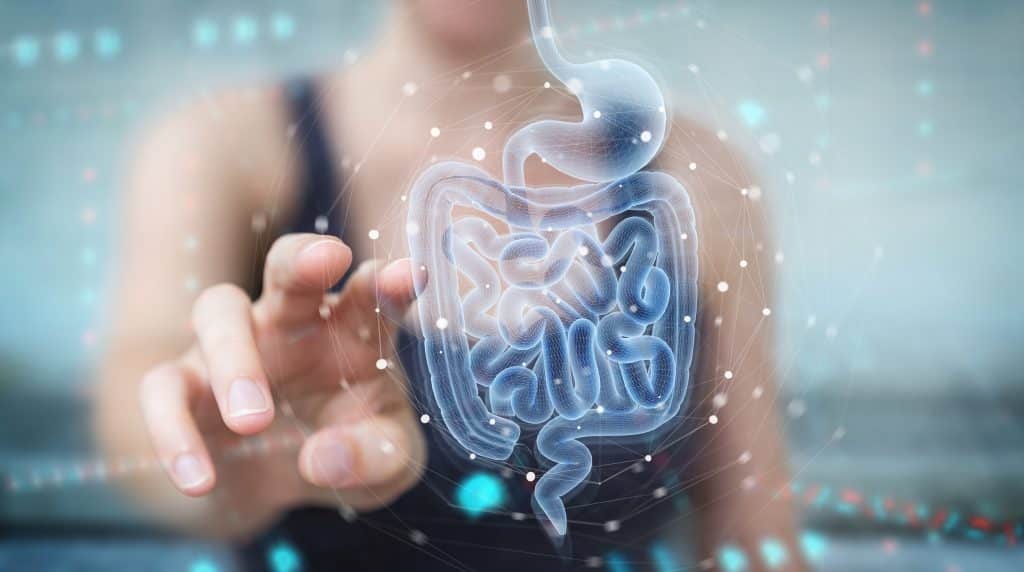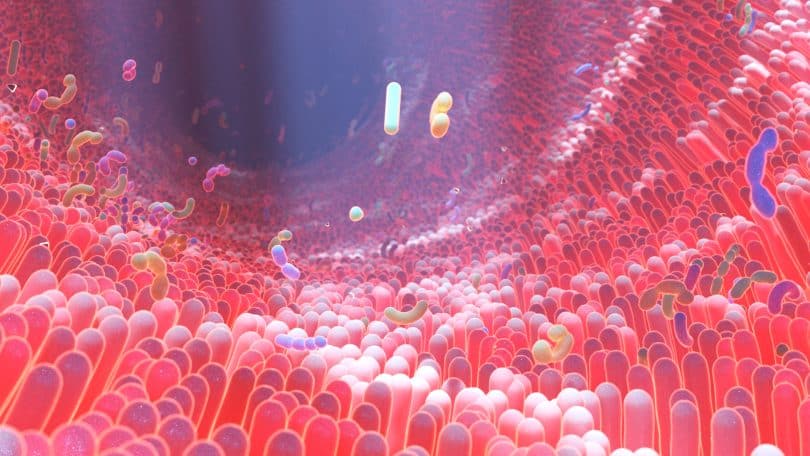Digestive issues are amongst the most common disorders in the world, which is why researchers are always keen to discover new therapies to treat gastrointestinal (GI) conditions. The discovery of endocannabinoid system receptors in the GI tract has led researchers to examine links between cannabis and the gut, to ascertain if cannabinoid compounds can be used to rebalance an unhealthy microbiome.
To stay current on everything important happening in the industry, subscribe to The Cannadelics Weekly Newsletter. Also, it’ll get you premium access to deals on cannabis flowers, vapes, edibles, and much more! We’ve also got standout offers on cannabinoids, like HHC-O, Delta 8, Delta 9 THC, Delta-10 THC, THCO, THCV, THCP & HHC, which won’t kill your bank account. Head over to our “Best-of” lists to get these deals, and remember to enjoy responsibly!
What is the Microbiome?
Trillions of bacteria, fungi and viruses live along the GI tract and on the skin. In fact, there are more bacterial cells in the body than human cells, about 40 trillion bacteria to 30 trillion human cells, meaning the body is made up mostly of these microbial organisms, known collectively as the microbiome. When referring to the microbes in a specific area of the body, they’re known as microbiota.
The microbes in the GI tract are referred to as gut microbiome, and are mostly found in a pocket of the large intestines, known as the cecum. Though there are many types of microbes, bacteria are the most studied. There are more than 1,000 types of bacterial microbes in the gut microbiome, and each plays a vital role in maintaining overall health.
In the past, it was thought that the gut was only responsible for digesting food, but now it’s known the interaction between the gut microbiome and brain plays such an important role in overall wellbeing, the stomach has been dubbed, the “second brain.” As food is digested, enzymes are created, firing neurotransmitters that influence everything from weight, blood flow, bone growth and heart health to immunity, libido, sleep and mood.
Poor gut health can cause an array of problems, leading to obesity, heart attack, stroke, type 2 diabetes and high cholesterol. In addition, the gut influences brain function through the Vagus Nerve, sending a constant stream of messages in the form of neurotransmitters, signaling the brain to release hormones that regulate body and mental health. Other outcomes of poor gut health include anxiety and depression.
What is the Endocannabinoid System?
The endocannabinoid system (ECS) was discovered by the Israeli chemist Raphael Mechoulam in the early 1990s, as part of his research into cannabis compounds. In 1992, Mechoulam’s lab isolated the first endocannabinoid, a molecule now classified as a CB1 receptor partial agonist, and named anandamide. Soon after, another endocannabinoid was discovered, 2-arachidonoylglycerol, or 2-AG.
In fact, there are hundreds of endocannabinoids active throughout the body, but these two are the most studied. Endocannabinoids are types of molecule produced by the body that act on receptors to keep all systems working optimally.Endocannabinoids behave differently from other neurotransmitters. Neurotransmitters are stored in vesicles and released when activated by a presynaptic neuron, acting postsynaptically. By contrast, endocannabinoids are produced on demand, where and when needed. They are released by postsynaptic neuron and act presynaptically. They bind to receptors to activate signaling.

There are two main forms of receptors: CB1 receptors, found mostly in the central nervous system (CNS) and CB2 receptors, found in immune cells. CB1 is one of the most abundant G-protein-coupled receptors in the CNS. CB1 receptors are present in the neocortex, hippocampus, basal ganglia, cerebellum and brainstem.
As well as immune cells, CB2 receptors are found in the peripheral nervous system, and are associated with inflammation, addiction and synaptic plasticity. Endocannabinoids can bind to either receptor. The effect depends on where the receptor is located and which endocannabinoid binds to it.
Links between ECS and the Microbiome
Much research needs to be done to understand the full scope of the ECS, but one of its functions appears to be a modulator between the digestive, nervous, and immune systems. In the same way that the gut microbiome works to maintain overall wellbeing, or homeostasis (a state of balance between the body’s organs), so too does the ECS.
Research links the ECS to the following functions: appetite, digestion, metabolism, inflammation, chronic pain, mood, learning, memory, motor control, sleep, heart health, liver function, stress and reproductive health. As the gut microbiota also plays a key role in these functions, it easy to see how an imbalance in one system can have knock-on effects to the other systems.
For example, endocannabinoids might target CB1 receptors in the spinal nerve to relieve pain. Others might bind to CB2 receptors in immune cells to signal the body is experiencing inflammation, a common sign of autoimmune disorders. CB1 receptors have a direct action on the gut, and have been shown to modulate intestinal motility.
More than that, a growing body of evidence now confirms the presence of a “gut-endocannabinoid axis,” which determines the integrity of the gut barrier by influencing both gut barrier function and intestinal permeability. Research has shown that increases or decreases in certain endocannabinoids affect the number of good probiotic bacteria in the gut. Because cannabis is a phytocannabinoid that acts on the ECS, it has the capacity to bridge the ECS and gut microbiota.
Can Cannabis Balance the Microbiome?
In vitro assays (cell research in glass) have shown that cannabis has antimicrobial properties. The human gut contains 4 main phyla: Firmicutes, Bacteroidetes, Actinobacteria, and Proteobacteria, of which Firmicutes and Bacteroidetes are linked to obesity and colorectal cancer.
A high Firmicutes: Bacteroidetes ratio is typical with obesity, and new research shows a balanced ratio can be restored in mice using the psychoactive cannabis compound, Delta-9-tetrahydrocannabinol (THC.) In obese mice, the gut microbiota modifies endocannabinoid signaling, resulting in increased gut permeability, inflammation and fat storage.

THC has been shown to block this effect by increasing the presence of bacteria called Akkermansia mucinphila, which control fat storage and metabolism to facilitate weight loss. This bacterium can also strengthen signaling between the gut and the brain, and strengthen the gut barrier. It also linked to improved glucose tolerance and glucose metabolism.
Research on long-term users of cannabis has shown that users display Prevotella: Bacteroides ratio 13-fold lower than non-users. Though further research is required to assess the full implications of this finding, what is clear is that cannabis use leads to alterations in gut microbiome, which due to the interconnectivity of the ECS, affects other physiological systems, including brain function.
It’s also clear that there are links between the gut microbiome and both gastrointestinal and neurodegenerative disorders. The ability of THC to change the gut microbiome, by increasing the number of healthy bacteria that protect against obesity and associated conditions, suggest its restorative capacity to balance the microbiome.
Finally Thoughts on Cannabis and the Microbiome
A 2016 article that reviewed over 10 years of research suggests the theory that endocannabinoid deficiency could be the source of autoimmune disorders including fibromyalgia and irritable bowel syndrome, as well as migraine. However, because the full scope of the ECS is not understood, medical applications are still evolving.
The drug rimonabant was developed to aid weight loss by blocking the CB1 receptor. The thinking was that if the ECS controls hunger, a drug that blocked signaling could cause weight loss. The drug worked in this regard but because the ECS is so connected to other functions, rimonabant also caused some nasty side effects on mood. People who took reported feeling suicidal. Rimonabant was removed from the market.
However, it’s easy to imagine that with better understanding of the ECS and the workings of endocannabinoids, it will be possible in the future to develop cannabis medications with more direct actions that provide relief by alleviating symptoms of digestive orders and/or rebalance the microbiome.
Welcome all! Thanks for dropping by Cannadelics.com, a top offering for comprehensive news covering the burgeoning cannabis and psychedelics industries. Stop by daily for a dose of news on these dynamically changing fields, and sign up for The Cannadelics Weekly Newsletter, so you’re up on everything important going on.









